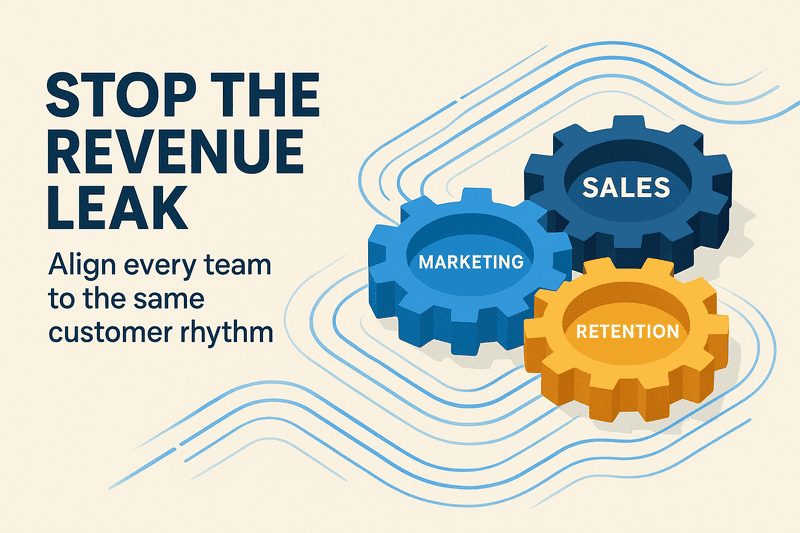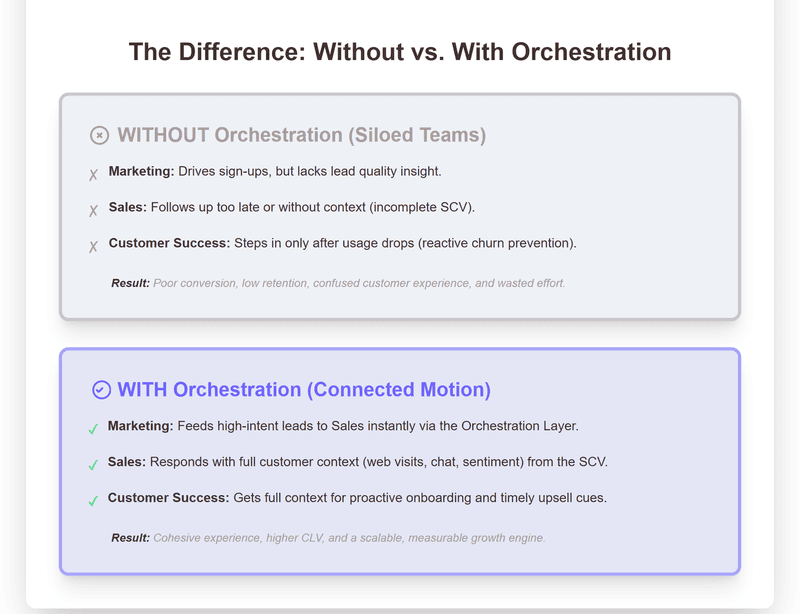Revenue Orchestration: The Missing Link Between Your Marketing, Sales, and Retention Goals

Nearly seven out of ten companies are leaking revenue not because their product isn’t strong or their teams aren’t skilled, but because those teams aren’t working together.
Revenue orchestration solves this by aligning every customer-facing team into one connected motion. Instead of marketing chasing vanity metrics, sales working blind, and retention scrambling post-sale, everyone operates from a shared playbook and unified-single customer view.
This matters more than ever. Because the modern customer journey doesn’t move in a straight line. A buyer might discover your brand on social media, read an email, talk to sales, and then reappear six months later with a support ticket. Without orchestration, each team treats that customer as a stranger. With orchestration, they’re recognized instantly, and every touchpoint builds on the last.
In this blog, we’ll break down what revenue orchestration really means, the pillars that make it work, its benefits and challenges, and a before-and-after view of what it looks like in practice. By the end, you’ll know exactly how to turn disconnected motions into a single, revenue-generating rhythm.
What is Revenue orchestration
At its simplest, revenue orchestration is how marketing, sales, and customer success teams operate as one connected growth engine. It’s the framework that ensures every lead, conversation, and customer moment contributes to the same revenue outcome.
In most organizations, these teams work hard, but separately. Marketing drives demand, sales closes deals, and customer success handles renewals. Yet somewhere between those handoffs, valuable context gets lost. Revenue orchestration fixes that by creating a unified layer where data, intent, and actions flow together in real time.
Every interaction, a click, a chat, a call, even a tone of voice, feeds into a living network of insights. This dynamic view acts as a “conversation graph,” helping teams understand not just what customers did, but what they’re likely to do next. Combined with an active customer profile that updates with every new signal, the system ensures no opportunity slips through the cracks.
For marketing, that means smarter targeting and better-qualified leads.
For sales, it means perfectly timed outreach.
For customer success, it means anticipating needs before they turn into churn risks.
The orchestration layer ties it all together, automatically triggering the next best action, whether that’s a personalized email, a sales alert, or a retention workflow, keeping momentum alive across the entire Customer journey.
The Core Pillars of Revenue Orchestration
Effective revenue orchestration doesn’t happen by chance, it’s built on a foundation of alignment, insight, and intelligent execution.
Unified Data Foundation
Every orchestration strategy starts with connected data. By centralizing customer and revenue data across CRM, marketing automation, and analytics tools, teams operate from a shared source of truth. This unified layer gives visibility into the full customer journey, from first click to renewal.
Context-Driven Customer Understanding
Numbers alone can’t tell the whole story. Orchestration thrives when teams capture both quantitative metrics and qualitative data, the intent behind a click, the sentiment in a message, the mood in a conversation. This deeper context allows teams to respond with empathy and precision, ensuring every interaction aligns with where the customer truly is in their journey.
Intelligent Orchestration Layer
This is the decision-making core, the layer that interprets signals and determines the next best action automatically. Whether it’s routing a lead to sales, triggering a follow-up email, or alerting customer success to a churn risk, the orchestration layer ensures every move is timely, relevant, and revenue-focused.
Measurement and Insights
You can’t orchestrate what you don’t measure. Common KPIs like pipeline velocity, conversion rates, and customer lifetime value (CLV) provide the feedback loop that fuels continuous improvement. As outcomes feed back into the system, orchestration becomes smarter, faster, and more predictable.
When teams operate from one shared truth, every interaction becomes part of a single, compounding revenue story.
Benefits & Goals of Revenue Orchestration
When marketing, sales, and customer success operate in isolation, it’s like three engines pulling in different directions, plenty of motion, little momentum. Revenue orchestration brings every function into sync, turning operational noise into measurable growth.
1. Eliminate Friction Between Teams
No more dropped leads, delayed handoffs, or misaligned campaigns. Orchestration ensures every team moves in rhythm, marketing knows what sales needs, sales understands what the customer success team is hearing, and all actions ladder up to the same revenue objective.
2. Improve Conversion and Retention Rates
Orchestration helps you meet customers exactly where they are informed by intent, timing, and sentiment. Marketing engages with relevance, sales responds with precision, and customer success steps in before churn risk even appears.
3. Deliver Consistent, Context-Driven Experiences
Customers don’t see departments, they see one brand. Revenue orchestration makes that possible by ensuring every message, follow-up, and offer feels cohesive, whether it’s a social ad, a demo call, or a renewal chat. This consistency builds trust
4. Create a Predictable, Measurable Revenue Engine
With shared KPIs like pipeline velocity, win rates, and customer lifetime value (CLV), orchestration transforms growth from reactive to predictable. Every signal feeds into the orchestration layer, which learns what drives results and continuously optimizes across the revenue journey.
Challenges of Revenue Orchestration (and How to Overcome Them)
Even with a solid strategy, many teams struggle to operationalize revenue orchestration.The challenge isn’t lack of ambition, it’s fragmentation of data and workflows that live in silos, alignment breaks down and momentum stalls.
1. Data Silos and Fragmented Visibility
When customer data lives in separate systems, CRM, marketing automation, analytics, teams only see part of the story. Without a unified Single Customer View (SCV), orchestration can’t connect actions to outcomes.
An active SCV breaks silos by merging behavioral, transactional, and qualitative signals into one dynamic record that drives coordinated action across every function.
2. Misaligned Processes and Handoffs
Even with the right data, orchestration fails when teams operate out of sync. Leads drop, follow-ups delay, and customers feel the gaps.
A Conversation Graph mapping every interaction into one continuous journey and creates shared visibility, so marketing, sales, and success move in the same rhythm.
3. Inconsistent Measurement and KPIs
When each team tracks its own metrics, growth feels disconnected. Aligning around shared KPIs like pipeline velocity, conversion rates, and CLV turns orchestration into a measurable, repeatable system.
With and Without Revenue Orchestration
Without revenue orchestration, even great teams struggle to stay connected. Marketing generates leads, but sales doesn’t know which ones are ready. Sales closes deals, but customer success isn’t aware of the client’s expectations. Everyone works hard, but in different directions.
Take a SaaS company as an example. Marketing runs a campaign that drives hundreds of sign-ups. But because data lives in silos, sales gets incomplete insights and follows up too late. Customer success steps in only after usage drops. The result? Poor conversions, low retention, and a confused customer experience.
Now imagine the same scenario with revenue orchestration.
The company operates from a unified Single Customer View (SCV) that merges all signals web visits, chats, in-app behavior, and sentiment. The Conversation Graph
connects these touchpoints into one live journey. When a prospect shows intent, the orchestration layer alerts sales instantly. Once converted, customer success receives full context, enabling proactive onboarding and timely upsell cues.
Every touchpoint flows into the next, every team sees the same story, and every decision links back to revenue impact.
